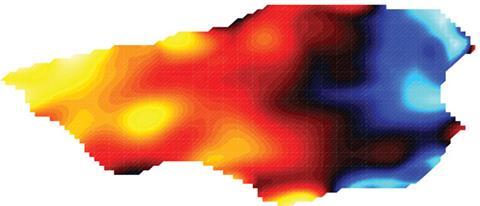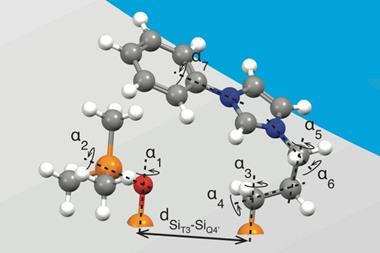Scientists in the US have used NMR to create temperature maps of reactions taking place inside catalytic reactors. Their technique opens the door to an easy, non-invasive way to discover hot and cold ‘spots’ inside reactors.
When optimising the design of reactors, chemical engineers use sensor probes, such as thermocouples, to determine the temperature of the reaction. But, with the most common catalytic reactions occurring between a solid and a gas, introducing a sensor inside the reactor can disrupt gas flow, meaning the parameters measured are, at best, an approximation.

Bouchard and his team used a magnetic field gradient across the reactor to determine temperature via NMR. By applying an uneven field they were able to encode for space, as different sites of the reactor experienced a different strength of field. They used NMR to probe the temperature in small ‘pixels’ of the reactor. At higher temperatures gas molecules moved faster, averaging out the magnetic gradient in their ‘pixel’, while at low temperatures gas molecules experienced an array of field strengths due to their static motion. Plotting this motional average allowed the team to accurately measure the temperature at different spots across the reactor.
Bouchard used the technique to create millimetre scale temperature maps for the hydrogenation of propylene. The team also demonstrated their technique on an even smaller scale – tens of micrometres – by using parahydrogen as a reactant to increase signal strength.
‘We can use our technique to probe the temperature and make sure it’s optimal throughout the whole volume of the reactor,’ says Bouchard. ‘Without this kind of information there are hot spots and cold spots, whereas ideally you’d like it to be uniform throughout the reactor.’
Kai Jarosch, catalyst manager at Velocys, says: ‘Making temperature measurements in fixed bed reactors is always a balance between observing the situation and disturbing the situation. Getting this balance right is particularly important in applications such as microchannel and minichannel reactors where the physical dimensions of your catalyst, reaction channel and measurement device are of the same order of magnitude. [Bouchard’s technique] promises to provide a new route to model validation, as well as providing direct insight into the behaviour of small packed beds.’
‘Microcatalytic reactors are very exciting new tools for the efficient syntheses of a number of chemicals,’ adds Jeffrey Reimer, a chemical engineer at the University of California, Berkeley, US. Reimer says this non-invasive method could provide new insight into these novel reactors.
The team now hope to apply their technique to other systems, such as multi-step reactions, as well as using it to screen a number of different catalysts in parallel.







No comments yet